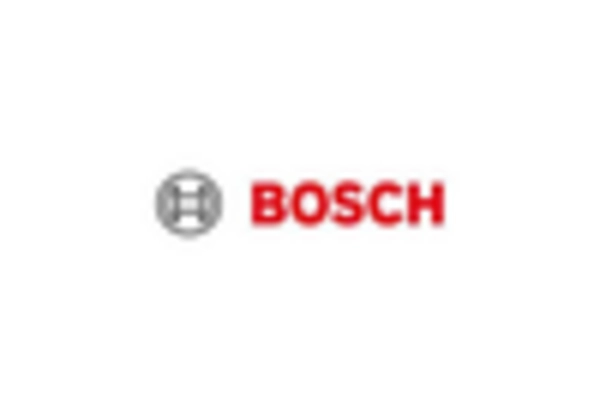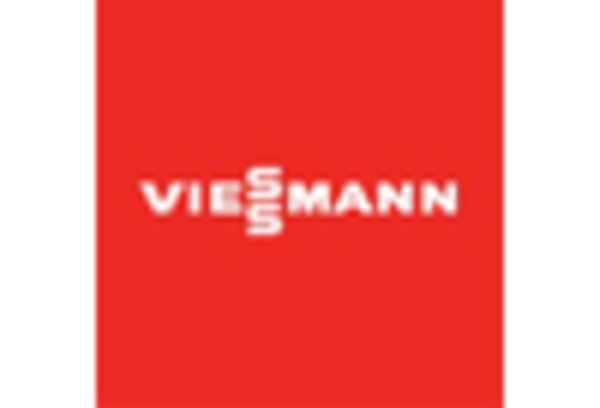Rising Energy Demand
The increasing The Oil Fired Boiler Industry. As industrialization and urbanization continue to expand, the need for efficient heating solutions becomes more pronounced. In 2025, the energy consumption is projected to rise by approximately 2.5% annually, leading to a heightened reliance on oil-fired boilers for both residential and commercial applications. This trend is particularly evident in regions where natural gas infrastructure is limited, making oil-fired boilers a viable alternative. The Oil Fired Boiler Market is likely to benefit from this surge in energy requirements, as these systems provide reliable and effective heating solutions. Furthermore, the versatility of oil-fired boilers in various applications, including manufacturing and power generation, positions them favorably in a competitive energy landscape.
Technological Innovations
Technological advancements play a crucial role in shaping the Oil Fired Boiler Market. Innovations in boiler design and efficiency have led to the development of high-efficiency oil-fired boilers that significantly reduce fuel consumption and emissions. For instance, modern oil-fired boilers now incorporate advanced control systems and heat recovery technologies, enhancing their operational efficiency. The market is witnessing a shift towards smart boilers that can be integrated with IoT systems, allowing for real-time monitoring and optimization of performance. As these technologies evolve, they not only improve the environmental footprint of oil-fired boilers but also appeal to consumers seeking cost-effective heating solutions. The Oil Fired Boiler Market is expected to see increased adoption of these innovative technologies, driving growth and enhancing competitiveness.
Increasing Industrial Applications
The expansion of industrial applications is a significant driver for the Oil Fired Boiler Market. Industries such as food processing, textiles, and chemicals rely heavily on steam and hot water for their operations, making oil-fired boilers an essential component of their infrastructure. In 2025, it is estimated that the industrial sector will account for a substantial share of the oil-fired boiler market, driven by the need for reliable and efficient heating solutions. The ability of oil-fired boilers to provide high-temperature steam and consistent heat makes them particularly suitable for various industrial processes. Furthermore, as industries seek to enhance productivity and reduce downtime, the demand for robust and efficient oil-fired boilers is likely to increase, further propelling the growth of the Oil Fired Boiler Market.
Regulatory Support for Oil Heating
Regulatory frameworks supporting oil heating systems are influencing the Oil Fired Boiler Market positively. Many regions have established policies that promote the use of oil-fired boilers, particularly in areas where alternative energy sources are less accessible. For example, certain governments offer incentives for the installation of energy-efficient oil-fired boilers, which can lead to reduced operational costs for end-users. Additionally, regulations aimed at improving air quality and reducing greenhouse gas emissions are pushing manufacturers to innovate and produce cleaner-burning oil-fired boilers. This regulatory support not only fosters market growth but also encourages the development of more sustainable technologies within the Oil Fired Boiler Market. As regulations evolve, the industry is likely to adapt, ensuring compliance while meeting the growing demand for efficient heating solutions.
Cost-Effectiveness of Oil-Fired Boilers
The cost-effectiveness of oil-fired boilers is a compelling driver for the Oil Fired Boiler Market. Compared to other heating systems, oil-fired boilers often present a lower initial investment, making them an attractive option for both residential and commercial users. In many regions, the price of oil remains competitive, allowing users to benefit from lower operational costs. Additionally, advancements in boiler technology have led to improved efficiency, which translates to reduced fuel consumption and lower energy bills. As consumers and businesses alike seek to optimize their heating expenditures, the appeal of oil-fired boilers continues to grow. This cost-effectiveness, combined with the reliability and performance of oil-fired systems, positions the Oil Fired Boiler Market favorably in a diverse energy market.


















Leave a Comment